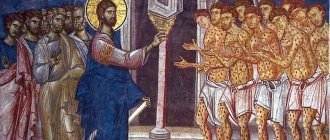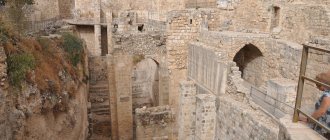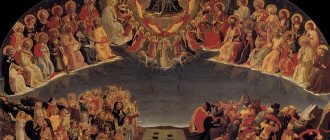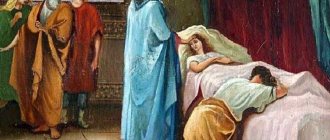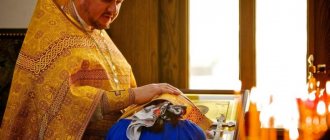HEALING OF THE PALASIS IN CAPERNAUM
(Mark 2:1–12; Matt. 9:1–8; Luke 5:17–26)
After healing the leper in Galilee and after traveling to Jerusalem, Christ again came to Capernaum; “and it was heard that He was in the house. Many immediately gathered, so that there was no longer room at the door; and He spoke the word to them.” Among the listeners, as Evangelist Luke testifies, “sat the Pharisees and teachers of the law, who came from all the places of Galilee and Judea and from Jerusalem, and the power of the Lord appeared in the healing of the sick.”
Apparently, at this time Christ healed many sick people, as He usually did at a gathering of people, but here the weather forecasters describe in detail the miracle of healing only one paralytic, who was carried into the house through the dismantled roof and laid on the floor in front of Jesus.
The Evangelists talk about this event like this: “...they came to Him with a paralytic, who was carried by four; and, not being able to approach Him due to the crowds, they opened the roof of the house where He was, and, having dug through it, lowered the bed on which the paralytic lay.” “And Jesus seeing their faith, said to the paralytic: Be of good cheer, child! Your sins are forgiven you."
Here, first of all, it should be noted that Christ performs the miracle of forgiveness of sins to the paralytic according to the faith of “theirs,” i.e. by faith
four
who brought the patient.
This is a powerful “conciliar faith”, about which the Lord later said: “If two or three agree on earth about anything they ask, it will be done for them by My Father in heaven” (Matthew 18:19).
Christ encourages and has mercy on the sickest person with the powerful word: “Be of good cheer, child!” (i.e. son, child): - be bold in your faith and hope, do not be afraid of the extraordinary conditions in which you find yourself, nor of this crowd of people that surrounds you; you are a sinner, but your sins are forgiven you according to the faith of those who pity and love you, and according to your own faith!
Hearing the word of Christ about the forgiveness of sins, the Pharisees and teachers of the law became agitated and began to whisper among themselves, saying to themselves: “Why is He blaspheming so much? Who can forgive sins except God alone?” – These people were not able to feel the presence
among them
was God Himself,
and their religious dogma did not allow the forgiveness of sins by man to man.
They did not know - although they could have known as “teachers of the law” - that every illness is a consequence of sin.
Having recognized by His spirit the thoughts of His opponents, Christ said to them: “Why do you think this way in your hearts?” And he immediately established before them the truth about the inextricable connection between sin and illness: “Which is easier?” - He asked the Pharisees, “should I say to the paralytic: “Your sins are forgiven?” or to say, “get up, take your bed and walk?”
With these words, Christ seemed to draw an equal sign between these two concepts, i.e. that if there were no sin, there would be no disease. The Fall is the common cause of illness and suffering of mankind. But power over the forces of sin is in the hands of the Son of Man. And He is present here
in the house, and it is He who forgives and heals!
And then Christ clearly declared to His opponents: “But (you must) know that the Son of Man has power on earth to forgive sins.” And turning to the paralytic, he said to him: “I say to you: get up, take up your bed and go to your house.”
And a miracle happened: the paralytic stood up and went out in front of everyone, “so that everyone was amazed and glorified God, saying: we have never seen anything like this.” And according to Matthew: “When the people saw this, they were amazed and glorified God, who had given such power to men.”
To this people, Jesus was here as a “man” with authority from God. For the people, as can be seen, in this miracle not the whole truth about Christ as the Son of God was revealed, but only one side of this truth. The mystery of God's Sonship remained incomprehensible.
The relaxed man in the Bible is a paralytic
To begin with, a little about what is relaxed in such a patient, why is he called that. “Relaxed” is an outdated term for people with paralysis.
This is a disease of the brain (both brain and spinal).
The Bible Encyclopedia reports:
“a disease that deprives a person of free movement, and thus the connection between the will and the affected part is severed. In the sense in which the word is used in the New Testament, it can mean apoplexy or paralysis of the whole body, paralysis of one side of the body, paralysis from contraction of the muscles, so that the members of the body cannot be lifted or stretched, and then the affected parts of the body soon become completely withered. This disease is still widespread in the East. The members of the body remain motionless in the same position in which they were caught by a sudden attack, and the suffering is sometimes so severe that death occurs soon after the attack.”
From what archeology reports about the medicine of that time, it is clear that such a patient had no hope of recovery at the time of Christ.
Healing of the paralytic in Capernaum. To deliver the sick man to Christ, people dismantled the roof and lowered the paralytic on ropes (wood engraving, A. Gaber). Photo: iif.wellcomecollection.org
However, there are functional paralysis, which is a mental illness. They appear only in public, for demonstration, like how a stutterer suffers from his illness only in the presence of an audience. In the absence of spectators, the symptoms of such paralysis may disappear completely.
It is impossible to say which category the paralytic belonged to in the Bible.
There are also other meanings of the word “relaxed”, say, tired to the point of collapse, or a woman who is relaxed after a massage, but this is beyond the scope of the article.
Illness and forgiveness of sins may be closely related
Another important point is the dependence of the disease on sins.
This does not always happen and not everywhere, but similar situations do occur. Associate Professor of the Kyiv Theological Academy Andrey Muzolf shares his thoughts on this topic:
“Every disease that befalls a person does not arise on its own, without any reason. Our condition depends on how we live, how we observe the Gospel commandments and universal human norms. If we neglect Christ’s commandments about spiritual perfection, then we will certainly be sick in soul. An illness of the soul entails an illness of the body. Sin, being a violation of the will of God, destroys the relationship between soul and body, disrupts their unity and makes us relaxed—relaxed, first of all, spiritually.”
Andrey Muzolf
Associate Professor at Kyiv Theological Academy
According to Orthodoxy, the soul can also be sick; this condition is called sinfulness.
And further Andrei Muzolf explains why Christ said: “Your sins are forgiven you”:
“Thus, physical illness is present in the world as a reflection of spiritual illness. Therefore, a person can only be truly healed when he is freed from sin. That is why Christ, before healing a person from a physical illness, says to him: “Your sins are forgiven!” Only by realizing this internal connection between the spiritual and physical in a person can we understand how important the internal, spiritual dimension of our life is for the fullness of human existence.”
Andrey Muzolf
Associate Professor at Kyiv Theological Academy
It is important to understand the idea: it is not the healing of an illness that depends on a righteous life, but its complete health. That is, a person, even if everything is fine with him physically, can never be healthy as long as he has problems in the spiritual sphere.
Only a harmoniously developed living being is completely healthy.
The ruins of the font were found, but poorly studied
The same font was discovered by the Dominicans. However, they did not have enough archaeological experience, so the excavations were carried out with many mistakes.
Tradition holds that the Sheep's Pool is a ruin at St. Stephen's Gate in the northeast corner of the Jerusalem Wall.
Ruins of the Sheep Pool. Photo: pilgrimcenter.ru
Proof of this is the 2nd century inscription: “Pompeia put in Lucilius,” which reports another miracle of healing here.
This building has not been studied enough; it is not even possible to say exactly when the fonts were built. But, most likely, several hundred years BC. Initially, a pagan sanctuary could well have been located here.
The paralyzed is the soul of a person, and illness is his sins
The Orthodox Church celebrates the Sunday of the Paralytic every fourth Sunday after Easter.
This event is not the victory of one person over the disease, but an indication that faith can heal everyone. Liturgical texts compare the soul of every person to a paralytic, and sins are called the cause of his illnesses.
The story of the paralytic is a lesson in faith for every person.
Healing is given by Jesus Christ Himself. Moreover, this is not a miracle according to schedule, as happened in the font before. Now every person has the opportunity to turn to Higher powers with a request for help in returning their spiritual nature.
The following texts exist for the holiday:
Ikos
voice 3
O Lord, my soul, severely weakened from all kinds of sins and from undue deeds, raise up my soul through Your divine care, just as You once raised up the paralytic, so that I, saved, cry out to You: “Glory, O Merciful Christ, to Your power!”
Kontakion
Holding the ends of the world with Your handful, Jesus, God, like the Father without beginning, and together with the Holy Spirit ruling over all, You appeared in the flesh, healing ailments; and drove away passions; He gave the blind to see the light, and raised up the paralytic with a divine word, suddenly commanding him to walk and lift the bed that carried him onto his shoulders. Therefore, we all sing with him and cry out: “Glory to Thy might, O Merciful Christ!”
By leaving a comment, you accept the user agreement
Jesus healed the second paralytic at the Sheep Pool
The second story about the paralytic is known from the Gospel of John (5:1–15):
“It was a Jewish festival, and Jesus came to Jerusalem. There is also a pool in Jerusalem at the Sheep Gate, called Bethesda in Hebrew, which had five covered passages. In them lay a great multitude of sick, blind, lame, withered, waiting for the movement of the water, for the angel of the Lord from time to time went into the pool and disturbed the water, and whoever first entered it when the water was disturbed, he recovered, no matter what disease he was possessed by. Here was a man who had been ill for thirty-eight years. Jesus, seeing him lying down and learning that he had been lying there for a long time, said to him: Do you want to be healthy? The sick man answered Him: Yes, Lord; but I do not have a person who would lower me into the pool when the water is troubled; when I arrive, another has already descended before me. Jesus says to him: get up, take up your mat and walk. And he immediately became well, and took up his bed and went. It was on the Sabbath day. Therefore the Jews said to the healed man: Today is the Sabbath; You shouldn't take the bed. He answered them: He who healed me said to me: take up your bed and walk. They asked him: Who is the man who said to you, “Take up your bed and walk?” The healed one did not know who He was, for Jesus hid himself among the people who were in that place. Then Jesus met him in the temple and said to him, “Behold, you are made well; Don’t sin anymore, lest something worse happen to you. The man went and announced to the Jews that the one who healed him was Jesus.”
(5:1–15)
This is precisely the story that is meant when they talk about the paralytic, although it is given in the Gospels once, not three. It is worth examining in more detail further.
Giovanni Battista Tiepolo “Healing of the Paralytic at the Sheep Font”, at the top there is an angel - the same one who performed annual healings
A relaxed person is a person of great endurance and faith
Theologians emphasize what amazing self-control the paralytic possessed. After all, he didn’t spend two or three days in the font waiting for a miracle!
The Bible reports that the unfortunate man waited for a miracle for 38 years until the Savior appeared!
38 years
the paralytic spent in the font to receive healing
But his problem was not so much weakness as the lack of compassion among those around him.
This is how Archpriest Alexander (Shargunov) reasons:
“The relaxed man continued to lie by the water year after year, hoping that sooner or later help would come to him. And it is revealed to us that the first is not the one who first approaches the shrine, pushing aside others. And the one who confesses himself to be the first of sinners, and for this reason considers his situation to be the most hopeless. It is to him that Christ God comes first. Do you want to be healthy? - the Lord asks this question to every person. And there is probably not a single one who would hesitate in answering. “But I don’t have a person who would lower me into the pool when the waters are troubled,” the sick man answered Jesus, “but when I come, someone else is already going down before me.”
Alexander (Shargunov)
Archpriest
One of the baths in which healing could take place. Photo: icocnews.ru
